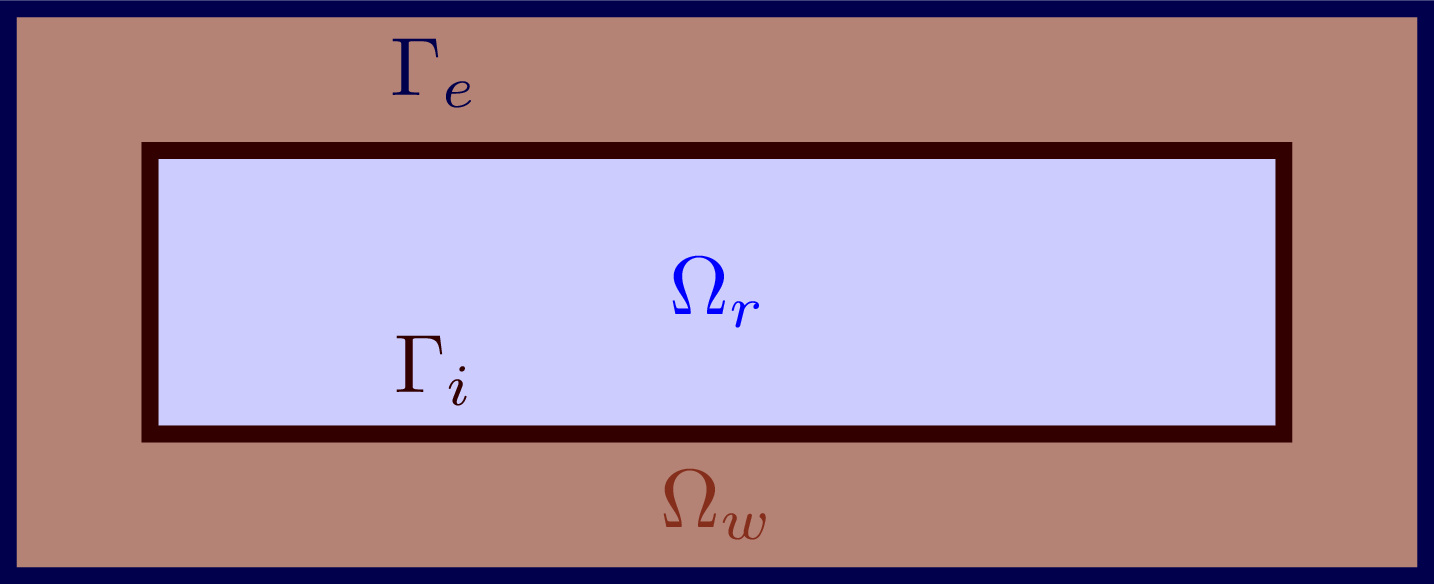Heat Air Moisture Modeling
1. Geometry
Here is an example of the geometry for the heat air moisture modeling.

In the following we will use those notations :
-
\(\Omega_r\) is the domain of the room
-
\(\Omega_w\) is the wall domain
-
\(\Gamma_{i}\) is the broder between the room and the wall
-
\(\Gamma_{e}\) is the border between the wall and the exterior
2. Heat transfer modeling
2.1. Equations
Here are the equation of heat transfert in the wall (equation \(\ref{hw}\)) and in the room (equation \(\ref{hr}\)), get from the benchmark BESTEST.
With :
-
\(T_w\) / \(T_r\) / \(T_e\) [K] is the wall / room / exterior temperature.
-
\(w_w\) / \(w_r\) / \(w_e\) [K] is the wall / room / exterior absolute humidity.
-
\(\phi_w\) / \(\phi_r\) / \(\phi_e\) [K] is the wall / room / exterior relative humidity.
-
\(T_e\) [K] is the exterior temperature.
-
\(\phi_w\) [\(-\)] is the rom relative humidity- \(\rho_m\) [\(\mathrm{kg} / \mathrm{m}^3\)] is the material density.
-
\(c_m\) [\(\mathrm{J} / \left(\mathrm{kg} . \mathrm{K} \right)\)] is the material thermal mass capacity.
-
\(k\) [\(\mathrm{W} \cdot \mathrm{m}^{-1} \cdot \mathrm{K}^{-1}\)] is the thermal conductivity.
-
\(\rho_a\) [\(\mathrm{kg} / \mathrm{m}^3\)] is the air density.
-
\(c_a\) [\(\mathrm{J} / \left(\mathrm{kg} \cdot \mathrm{K} \right)\)] is the air heat capacity.
-
\(V_a\) [\(\mathrm{m}^3\)] is the room volume.
-
\(\eta\) [\(\mathrm{h}^{-1}\)] is the ventilation rate.
-
\(h_i\) (resp. \(h_e\)) [\(\mathrm{W}/ \left(m^2 \cdot K\right)\)] is the inside (resp. outside) convective heat transfer coefficient.
-
\(A_w\) [\(\mathrm{m}^2\)] is the total area of the walls.
-
\(\xi\) [\(\mathrm{kg} / \mathrm{m}^{3}\)] is the moisture storage capacity.
-
\(L_\mathrm{v}\) [\(\text{J}\,\text{kg}^{-1}\)] is the latent heat of evaporation.
-
\(\delta_{\mathrm{p}}\) [s] is the vapor permeability.
-
\(p_{\text {sat }}\) [\(\mathrm{Pa}\)] is the vapor saturation pressure.
-
\(D_{\mathrm{w}}\) [\(\mathrm{m}^{2} / \mathrm{s}\)] is the moisture diffusivity.
-
\(H\) [\(\text{W}\)] is the heating power.
The boundary conditions at the border \(\Gamma_{i}\) between the wall and the room are :
At the border \(\Gamma_{e}\) between the wall and the exterior the conditions are :
2.2. Variational problem
The solve this problem, we use a product of spaces
-
\(X_h\) corresponding to the wall
-
\(W_h\) corresponding to the room : as we consider the temperature as a constant on the room, we take in Feel++ the space
Pch<0>. This space corresponds to the piecewise-continous functions which are constant on each element of the mesh : there are therefore constant on all the domain. So, the space Pch<0> is equivalent to \(\RR\).
Equation \(\ref{hw}\) :
Let \(v\) be a test function associated to the wall space. As done before, we linearize the problem with this approxmation :
The equation \(\ref{hw}\) become :
It leads to, after a partial integration :
Which is equivalent, after appying the boundary conditions, as \(\partial\Omega_w = \Gamma_{e}\cup \Gamma_{i}\)
Equation \(\ref{hr}\) :
We apply the same Euler scheme on \(T_r\), the equation \(\ref{hr}\) becomes :
This equation gives this variational problem :
Find \(T_r^{n+1}\in\mathbb{R}\) such as \(\forall u\in \RR\) :
The variational problem is : find \(T^{n+1}=(T_w^{n+1},T_r^{n+1})\in X_h\times W_h\) such as forall test functions \(V=(v,u)\),
with :
-
\(A(T^{n+1},V) = \begin{bmatrix} \begin{pmatrix} \displaystyle\int_{\Omega_w}(\rho_mc_m)^n \frac{T_w^{n+1}}{\Delta t}v + \int_{\Omega_w} \left(k^n \nabla T_w^{n+1}\right)\nabla v + \int_{\Omega_w} \left(L_{\mathrm{v}}^n \delta_{\mathrm{p}}^n \phi_w^{n+1} \nabla\left(p_{\mathrm{sat}}^n\right)\right) \nabla v + \int_{\Omega_w} \left(L_{\mathrm{v}}^n \delta_{\mathrm{p}}^n p_{\mathrm{sat}}^n \nabla\left(\phi_w^{n+1}\right)\right) \nabla v \\ - \displaystyle\int_{\Gamma_{i}} \left(-h_i T_w^{n+1} - h_mL_\mathrm{v}(w_w^{n+1})\right) v + \int_{\Gamma_{e}} \left(h_eT_w^{n+1} + h_m L_\mathrm{v} w_w^{n+1}\right) v - \int_{\Gamma_{i}} \left(\left(L_{\mathrm{v}}^n \delta_{\mathrm{p}}^n \phi_w^{n+1} \nabla\left(p_{\mathrm{sat}}^n\right)\right)\right)v \\ - \displaystyle\int_{\Gamma_{e}} \left(\left(L_{\mathrm{v}}^n \delta_{\mathrm{p}}^n \phi_w^{n+1} \nabla\left(p_{\mathrm{sat}}^n\right)\right)\right)v - \int_{\Gamma_i} \left(\left(L_{\mathrm{v}}^n \delta_{\mathrm{p}}^n p_{\mathrm{sat}}^n \nabla\left(\phi_w^{n+1}\right)\right)\right)v - \int_{\Gamma_e} \left(\left(L_{\mathrm{v}}^n \delta_{\mathrm{p}}^n \phi_w^{n+1} \nabla\left(p_{\mathrm{sat}}^n\right)\right)\right)v \end{pmatrix} & - \displaystyle\int_{\Gamma_{i}} \left(h_i T_r^{n+1} + h_mL_\mathrm{v}w_r^{n+1}\right) v \\ - \displaystyle\int_{\Omega_r} h_iA_wT_w^{n+1} u & \displaystyle\int_{\Omega_r}\left(\left(\frac{\rho_ac_a}{\Delta t} + h_iA_w + \eta\rho_ac_a V_a\right)T_r^{n+1}\right)u \end{bmatrix}\)
-
\(f(V) = \begin{bmatrix} \displaystyle\int_{\Omega_w}(\rho_m c_m)^n\frac{T_w^n}{\Delta t}v + \int_{\Gamma_e} \left(h_eT_e^{n+1} + h_mw_e^{n+1}\right)v \\ \displaystyle\int_{\Omega_r}\left(H^{n+1} + \frac{\rho_ac_a}{\Delta t} T_r^n + \eta\rho_a c_a V_a T_e^{n+1}\right) u\end{bmatrix}\)
|
The matrix \(A\) represents the form such as the rows correspond to test functions and the columns correspond to the trial function. In our case, this like that :
|
3. Moisture transfer modeling
Here are the equation of heat transfert in the wall (equation \(\ref{mw}\)) and in the room (equation \(\ref{mr}\)), get from the benchmark BESTEST.
3.1. Equations
With those boundary conditions :
3.2. Variational problem
Wall equation \(\ref{mw}\) :
We do the same process as before to get the variational formulation, with a test function \(v\) :
Room equation \(\ref{mr}\) :
The equation \(\ref{mr}\) become, for a test function \(u\in\RR\) :
The variational formulation for the moisture problem is :
Find \(\phi^{n+1}=(\phi_w^{n+1},\phi_r^{n+1})\in X_h\times W_h\) such as forall test function \(V = (v,u)\) :
with :
-
\(B(\phi^{n+1},V) = \begin{bmatrix} \begin{pmatrix}\displaystyle\int_{\Omega_w}\xi^n\frac{\phi_w^{n+1}}{\Delta t}v + \int_{\Omega_w}\left(\xi^n D_\mathrm{w}^n\nabla\phi_w^{n+1} + \delta_\mathrm{p}^n\nabla\left(\phi_w^{n+1} p_\mathrm{sat}^n\right)\right)\cdot\nabla v \\ - \displaystyle\int_{\Gamma_i}\left(h_{m,i} w_w^{n+1}\right) v - \int_{\Gamma_e}\left(h_{m,e}w_w\right) v \end{pmatrix} & \displaystyle\int_{\Gamma_i}\left(h_{m,i} w_r^{n+1}\right) v \\ - \displaystyle\int_{\Omega_r}h_m A_w w_w^{n+1} u & \displaystyle\int_{\Omega_r}\left(\frac{V_a}{\Delta t}+\eta V_a + h_m A_w\right)w_r^{n+1} u \end{bmatrix}\)
-
\(g(V) = \begin{bmatrix} \displaystyle\int_{\Omega_w}\xi^n\frac{\phi_w^n}{\Delta t}v - \int_{\Gamma_e} (h_{m,e}w_e)v \\ \displaystyle\int_{\Omega_r}\left(\eta V_a w_e^{n+1} + \dot{m}_\mathrm{gen}\right)u \end{bmatrix}\)
4. Resolution wih Feel++
To solve such a problem with Feel++, we use product spaces. Mode details can be found in the internship report.